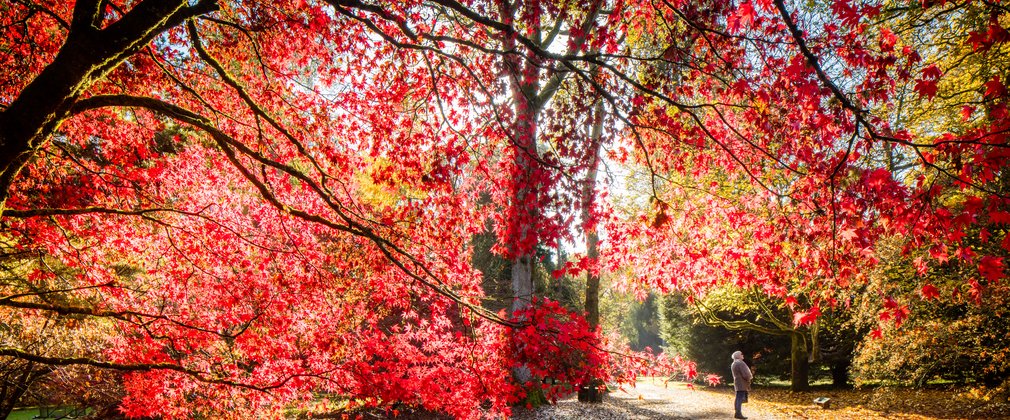
3 September 2024
Winter and spring downpours could lead to a vibrant autumn say Forestry England
Forestry England says the higher-than-average rainfall we experienced this year, particularly in the spring, has led to lush growth in the nation’s forests, which many may have also noticed in their gardens. These leaves, now full of sugars, could result in a spectacular autumn display. However, just how vibrant autumn colours will be will depend on the weather we experience in the coming months.
Data from the Met Office shows that most regions of England had more rain than usual during winter and spring. While too much rain in autumn can delay colour change and cause leaves to drop early, the abundant water in spring has helped trees to grow well and produce many sugar-rich leaves. This suggests we could see a rainbow of colour in the nation’s forests this year. For the best autumn colours, we also need plenty of sunshine during late summer and early autumn. If September and October bring us lots of sunshine, we should enjoy a beautiful display of colour.
Andrew Smith, Forestry England Director of Westonbirt Arboretum explains:
Trees produce sugars through photosynthesis, a process that needs plenty of water, sunlight and carbon dioxide. This year’s abundant rainfall that has helped our forest trees grow well and produce lots of leaves full of sugars. However, for a truly spectacular display, we also need to have plenty of sunshine during late summer and early autumn. If September and October bring sunny weather, we should see a stunning array of colours in the nation’s forests this year.
Weather conditions also influence when we start to notice autumn colour. With a changing climate, Forestry England are noticing changes happening a little later with colours extending way into November.
Andrew continues:
Leaf change is triggered by environmental cues like shorter days and cooler temperatures. Although we’ve had lots of rain this year, our seasons have been warmer. If the warm weather continues, the leaves will stay green longer, delaying the start of autumn colour. However, if it suddenly gets cold after a warm period, the leaves could start to change colour quickly.”
With a warming climate and changing rainfall patterns, Forestry England expert Andrew Smith adds that we are likely to continue to see changes to the nation’s forests and the autumn colours we enjoy.
Andrew explains:
Autumn’s foliage displays are certainly affected by the weather. For best colour we’d ideally have sunny days in autumn and also cool nights. These conditions accentuate leaf colour. However, extreme weather events, such as early heavy frosts or strong storms, can cause loss of leaves before they reach peak colour.
Climate change also creates longer-term threats to our trees. Warmer temperatures can stress trees, making them more vulnerable to pests like the oak processionary moth and diseases like acute oak decline. Additionally, climate change also promotes the spread of tree diseases. Together, these impacts can result in less vibrant and shorter autumn displays. In extreme cases such as chalara ash dieback, we risk losing entire trees or treescapes along with all the other benefits that trees bring for wildlife, people and climate.
To ensure that autumn is colourful for future generations and to increase the resilience of our nation’s forests in the fight against climate, Forestry England is working hard to grow forests for all, using lots of different species of trees. They are also carefully considering where the trees come from to ensure they can thrive in the expected climate conditions of the coming decades. Aspen, wild cherry, hornbeam, small-leaved lime, and oak are among the trees which should bring beautiful colour to our countryside for visitors to enjoy well into the future.
Forestry England invites everyone to visit the nation’s forests this autumn and witness the beauty of this season firsthand. Visit www.forestryengland.uk to find a forest near you and plan a visit.
Notes to Editor
- Images are available here. Please credit Forestry England/Crown copyright.
- Interviews on request with Andrew Smith, Forestry England Director of Westonbirt Arboretum
- Forestry England manages and cares for the nation’s 1,500 woods and forests, with over 285 million visits in 2023/24. As England’s largest land manager, we shape landscapes and enhance forests for people to enjoy, wildlife to flourish and businesses to grow. We are continuing the work we have already started to make the nation’s forests resilient to climate change and by 2026 we will:
- create at least 6,000 more hectares where we integrate wilding activities in our productive forests
- increase the diversity of visitors to the nation’s forests and have one million hours of high-quality volunteer time given to the nation’s forests
- plant at least 2,000 hectares of new, high quality, predominantly broadleaf woodlands
For more information visit forestryengland.uk. Forestry England is an agency of the Forestry Commission.
Media contact: media@forestryengland.uk
